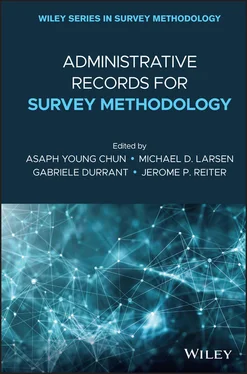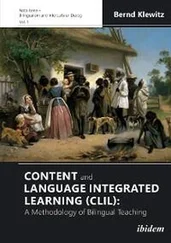Multiple macro-level proxy totals may need to be reconciled under the symmetric-unlinked setting. A typical example is multiple time series with different frequencies, e.g. with register-based yearly figures and survey-based sub-annual figures. Another example is the Supply-and-Use Tables for the production of GDP, where the initial estimates generally do not balance out because they are derived from different sources, or when the GDP is compiled using different approaches. Census output tables derived from fragmented data sources instead a one-number file is yet another example. See e.g. Bikker, Daalmans, and Mushkudiani (2013) and Mushkudiani, Daalmans, and Pannekoek (2014, 2015).
Reconciliation is often achieved as the solution to a constrained optimization problem. The approach requires the specification of two components. A loss function may be defined to measure the changes from the initial proxy estimates to the final reconciled estimates. The constraints that the final estimates must satisfy need to be explicitly stated, which may contain both equality and inequality constraints. Minimizing the loss function subjected to the constraints would then yield the final estimates. The approach is feasible without linked data across the sources. Notice that there are many advanced techniques of constrained optimization in Applied Mathematics, Engineering, and Computer Sciences.
Mushkudiani, Pannekoek, and Zhang (2016) develop scalar uncertainty measure of macro accounts to replace, say, the entire variance–covariance matrix of all the estimates involved. Devising simple summary statistical uncertainty measures for an accounting system such as the System of National Account can be helpful in at least two respects: (i) it can inform the choice among alternative adjustment methods that seem equally viable to start with, (ii) it can identify and assess the changes, or potential improvements, that are most effective in terms of the final estimated account directly. Implementation of the approach to the System of National Account is currently under development.
In this chapter, we have provided an overview of the uses of proxy variables when combining register and survey data. The nature of the proxy variables discussed is such that they are not subjects of data editing methods, even when they can be considered to have risen from some kind of measurement errors. The presence of proxy variables is a characteristic feature of the settings involving data from multiple sources, because in a single-source setting proxy variables can be eliminated by design. The various instances discussed in Section 1.2demonstrate the ubiquitous presence of proxy variables in multisource statistics. Sometimes proxy variables raise challenges because the conflict between them needs to be resolved, sometimes they are a blessing – indeed statistics may be impossible without them as in the case of capture–recapture methods for population size estimation. Either way, they always represent potentially useful sources of statistical information. We believe that the appropriate conceptualization, treatment, and usage of proxy variables provide a wide-ranging perspective, which enables one to draw on insights and experiences from diverse problems. An important theme for future research is the assessment of statistical uncertainty associated with indirect estimation based on unlinked data ( Table 1.1). Several methods are mentioned in Sections 1.3.2and 1.3.3, which however do not cover all the practical situations.
1 Axelson, M., Holmberg, A., Jansson, I. et al. (2020). A register-based census: the Swedish experience ( Chapter 8). In: Administrative Records for Survey Methodology (eds. A.Y. Chun and M. Larsen). Wiley.
2 Bikker, R., Daalmans, J., and Mushkudiani, N. (2013). Benchmarking large accounting frameworks: a generalized multivariate model. Economic Systems Research 25: 390–408.
3 Böhning, D., Van der Heijden, P.G.M., and Bunge, J. (2017). Capture–Recapture Methods for Social and Medical Sciences. Chapman & Hall/CRC.
4 Brackstone, G.J. (1987). Issues in the use of administrative records for statistical purposes. Survey Methodology 13: 29–43.
5 Brion, P. and Gros, E. (2015). Statistical estimators using jointly administrative and survey data to produce French Structural Business Statistics. Journal of Official Statistics 31: 589–609.
6 Brown, J.J., Diamond, I.D., Chambers, R.L. et al. (1999). A methodological strategy for a one-number census in the UK. Journal of the Royal Statistical Society, Series A 162: 247–267.
7 Burger, J., van Delden, A. and Scholtus, S. (2015). Sensitivity of Mixed-Source Statistics to Classification Errors. Journal of Official Statistics, 31: 489–506.
8 Chambers, R.L. and Clark, R. (2012). An Introduction to Model-Based Survey Sampling with Applications. Oxford University Press.
9 Chambers, R.L. and Ren, R. (2004). Outlier robust imputation of survey data. In: JSM Proceedings, Survey Research Methods Section. Alexandria, VA, 3336–3344. American Statistical Association.
10 Coutinho, W., de Waal, T., and Shlomo, N. (2013). Calibrated hot deck imputation subject to edit restrictions. Journal of Official Statistics 29: 1–23.
11 Deville, J.-C., Särndal, C.-E., and Sautory, O. (1993). Generalized raking procedures in survey sampling. Journal of the American Statistical Association 88: 1013–1020.
12 Di Cecco, D., Di Zio, M., Filipponi, D., and Rocchetti, I. (2018). Population size estimation using multiple incomplete lists with overcoverage. Journal of Official Statistics 34: 557–572.
13 Di Consiglio, L. and Tuoto, T. (2015). Coverage evaluation on probabilistically linked data. Journal of Official Statistics 31: 415–429.
14 Djerf, K. (1997). Effects of post-stratification on the estimates of the Finnish Labour Force Survey. Journal of Official Statistics 13: 29–39.
15 D’Orazio, M., Di Zio, M., and Scanu, M. (2006). Statistical Matching: Theory and Practice. Chichester: Wiley.
16 Dostál, L., Münnich, R., Gabler, S., and Ganninger, M. (2016). Frame correction modelling with applications to the German Register-Assisted Census 2011. Scandinavian Journal of Statistics 43: 904–920.
17 Fellegi, I.P. and Sunter, A.B. (1969). A theory for record linkage. Journal of the American Statistical Association 64: 1183–1210.
18 Fienberg, S.E. (1972). The multiple recapture census for closed populations and incomplete 2k contingency tables. Biometrika 59: 409–439.
19 Fosen, J. and Zhang, L.-C. (2011). Quality evaluation of employment status in register-based census. In: Proceedings of the 58th World Statistical Congress, Dublin, 2587–2596. International Statistics Institute.
20 Guarnera, U. and Varriale, R. (2015). Estimation from contaminated multi-source data based on latent class models. NTTS.
21 Herzog, T.N., Scheuren, F.J., and Winkler, W.E. (2007). Data Quality and Record Linkage Techniques. Springer.
22 Hogan, H. (1993). The post-enumeration survey: operations and results. Journal of the American Statistical Association 88: 1047–1060.
23 Houbiers, M. (2004). Towards a social statistical database and unified estimates at Statistics Netherlands. Journal of Official Statistics 20: 55–75.
24 Kline, R.B. (2016). Principles and Practice of Structural Equation Modeling, 4e. The Guilford Press.
25 Luna-Hernández, A. (2016). Multivariate structure preserving estimation for population compositions. University of Southampton, School of Social Sciences, Doctoral Thesis, 155 pp. https://eprints.soton.ac.uk/404689/
26 Mancini, L. and Toti, S. (2014). Dalla popolazione residente a quella abitualmente dimorante: modelli di previsione a confronto sui dati del censimento 2011. ISTAT working papers (in Italian).
Читать дальше












